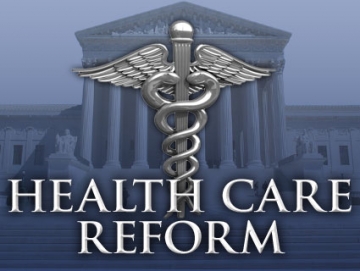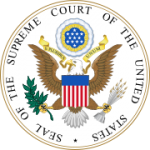Effects – Medicaid/Medicare « Affordable Care Act – Health Care Reform Act (2010)

Healthcare Reform Act of 2010
(the "Affordable Care Act")
(the "Patient Protection and Affordable Care Act")
Effects on Medicaid and Medicare
 Upheld by the Supreme Court – June 28, 2012
Upheld by the Supreme Court – June 28, 2012
National Federation of Independent Business et al v. Sebeluis, Secretary of State and Human Services, et al
-
Ruling of the Supreme Court – 6/28/12
In 2010, Congress enacted the Patient Protection and Affordable Care Act in order to increase the number of Americans covered by health insurance and decrease the cost of health care. One key provision isthe individual mandate, which requires most Americans to maintain“minimum essential” health insurance coverage. Another key provision of the Act is the Medicaid expansion.Twenty-six States, several individuals, and the National Federation of Independent Business brought suit in Federal District Court,challenging the constitutionality of the individual mandate and the Medicaid expansion.
The Court of Appeals for the Eleventh Circuit upheld the Medicaid expansion as a valid exercise of Congress’s spending power, but concluded that Congress lacked authority to enact the individual mandate. Finding the mandate severable from theAct’s other provisions, the Eleventh Circuit left the rest of the Act intact.
Held: The judgment is affirmed in part and reversed in part.
- Supreme Court on Health Care Law: How they Voted, What They Wrote (CNN – 6/28/12)
Chief Justice John Roberts wrote the majority opinion. He was joined by Justices Sonia Sotomayor, Stephen Breyer, Ruth Bader Ginsburg and Elena Kagan. Those in the dissent included Justices Anthony Kennedy, Samuel Alito, Antonin Scalia and Clarence Thomas.
Reactions to the Supreme Court Ruling (re Medicaid/Medicare)
- NAMD Statement on Supreme Court Decision (Natioinal Assn. of Medicaid Directors – 6/28/12)
Our reading is that the other Medicaid provisions in the ACA would continue to apply in the case of a state opting out. States will now have to make a series of decisions moving forward. Those include the political, fiscal, and policy calculations of whether or not this particular expansion makes sense. They will also have to factor in what may happen in the wake of the November elections, and HHS will assuredly have to promulgate guidance on the issue. The National Association of Medicaid Directors (NAMD) stands ready to assist all states in working through these issues and helping them make informed decisions about the future of the program in a way that meets the unique needs of each individual state.
Articles About Effects on Medicaid and Medicare:
- CMS Sends Medicare Mailing to Beneficiaries to Educate Them on the New Affordable Care Act and What it Means for Medicare (CGS – 5/28/2010)
Medicare beneficiaries will soon receive important information in the mail about the immediate benefits they may see from the enactment of the Affordable Care Act. - Explaining Health Care Reform: Questions About Medicaid's Role (Kaiser Family Foundation)
This brief explains the how Medicaid works today and answers some key questions about Medicaid’s role in health reform. - Final Rule Released for Medicaid Expansion (Health Leaders Media – 3/19/12)
The Department of Health and Human Services released Friday its final rules for the expansion of the Medicaid program under the Patient Protection and Affordable Care Act. - Health Care Reform and the Class Act (Kaiser Family Foundation – 4/10)
This brief describes the major components of the CLASS program, including eligibility, benefits, financing, and interaction with Medicaid. - HHS Announces New Affordable Care Act Options for Community-based Care (4/26/12)
New opportunities in Medicaid and Medicare that will allow people to more easily receive care and services in their communities rather than being admitted to a hospital or nursing home were announced today by Health and Human Services Secretary Kathleen Sebelius. HHS finalized the Community First Choice rule, which is a new state plan option under Medicaid, and announced the participants in the Independence At Home Demonstration program. The demonstration encourages primary care practices to provide home-based care to chronically ill Medicare patients. Both are made possible by the Affordable Care Act. Studies have shown that home- and community-based care can lead to better health outcomes. - How is the Affordable Care Act Changing Medicaid Today? State Adoption of Five New Options (Kaiser Family Foundation – 5/22/12)
This policy brief examines how states in every region have responded to five key opportunities available under the health reform law to help them prepare for the significant expansion of Medicaid in 2014. - How the New Health Care Law Benefits You (AARP)
Congress enacted a new health care law which brings a number of benefits to all Americans, including people over 50. Whether you are on Medicare, buy insurance on your own or through your employer, or can't afford health insurance, the changes to the health care system will affect you. - Huge Decisions Remain on Medicaid (New York Times – 6/29/12)
So what now? States have an enormous amount of work to do, including expanding Medicaid coverage to all individuals below 133 percent of the poverty line by January 2014 and establishing the health insurance exchanges where others can buy subsidized insurance by the fall. - Implementing the Affordable Care Act: New Options for Medicaid Home and Community Based Services (National Academy for State Health Policy) (NASHP)
This issue brief describes and analyzes four provisions of the health law that were specifically designed to give states additional options for financing Medicaid home and community-based services and supports through a combination of enhanced Medicaid matching payments, demonstrations, and new Medicaid state plan options. - Long-Term Services and Supports Opportunities in the Affordable Care Act (Center for Health Care Strategies – Dec. 2011)
A new technical assistance brief provides a brief outline of the Money Follows the Person, Balanced Incentives Payment Program, the Community First Choice Option, and the modified Home and Community-Based State Plan option. - People With Disabilities and Medicaid Managed Care: Key Issues to Consider (Kaiser Commission – Feb. 2012)
This brief considers the wide range of intensive and specialized medical and long-term care needs facing Medicaid beneficiaries with disabilities that may include spinal-cord and traumatic-brain injuries, cerebral palsy, autism, Alzheimer’s disease and severe mental illness, and the challenges states face in designing effective managed care programs that successfully meet those needs. - Predicting the Future (Kaiser Family Foundation – 5/6/10)
A fair amount of attention was given recently to projections made by the Chief Actuary of the Centers for Medicare and Medicaid Services (CMS) about the new health reform law, and how they compare to previous estimates by the Congressional Budget Office (CBO). No doubt the various projections will be grist for claims made in the upcoming political season, so it is important to be clear about the differences between the two estimates and to keep in mind what this kind of statistical modeling does and does not do. - Supreme Court Ruling Adds Uncertainty to Medicaid Program (Seattle Times – 7/5/12)
Starting in 2014, things could get worse for people on Medicaid: Some states might opt out of increasing the number of adults in the government health-insurance program for the poor as a result of the Supreme Court's ruling, and they might cut people who already are enrolled. Experts worry that those two developments taken together could spur some states to reduce the number of people covered. - The Future of Health Care – Federalising Medicaid (The Economist – 7/4/12)
According to the Hill, at least 15 governors, nearly all Republicans and empowered by the Supreme Court's ruling, have indicated that they will reject federal money to expand Medicaid in their states. That's a shame. Obamacare's expansion of Medicaid could provide health coverage for some 18m Americans who are currently without insurance. And the federal government is footing most of the bill. - The Health Care and Education Reconciliation Act – Section-by-Section Analysis
Title I – Coverage, Medicare, Medicaid and Revenues - The New Health Care Law: Medicare Prescription Drug Benefit & Closing the Doughnut Hole (AARP)
Under the new health care law, people enrolled in Medicare Part D this year who fall into the coverage gap, or "doughnut hole," will get an extra $250 to help pay for their drug costs. This is the first step toward closing the doughnut hole, which will be eliminated in 2020. - What the Health Care Ruling Means to You (CNN Politics – 6/28/12)
The Supreme Court's decision Thursday to uphold the Affordable Care Act means that the predictions about how it will affect Americans remain in place. The court did rule that a part of the law involving Medicaid must change. The law calls for an expansion of eligibility for Medicaid, which involves spending by the federal government and the states. The law threatens to remove existing Medicaid funding from states that don't participate in the expansion. The high court said the government must remove that threat. - What the Health Care Ruling Means for Medicare (New York Times – 6/28/12)
“This is great news for seniors on Medicare,” Paul Nathanson, executive director of the National Senior Citizens Law Center, a nonprofit advocacy group, said in a conference call on Thursday. Because several key provisions involving Medicare kicked in soon after Congress passed the bill in 2010, many beneficiaries won’t see big changes in their coverage now. But those improvements could have evaporated had the law been overturned, so the ruling generated sighs of relief among advocacy organizations for older adults. This means the annual free wellness exam will continue (about 2.2 million people took advantage of it last year, according to AARP), along with the first “Welcome to Medicare” visit, which will remain free, with no out-of-pocket costs. - What's in Health Care Reform for Elders? (Time Goes By) – 4-24-10
Many subscribers are concerned about potential cuts to their Medicare Advantage plans or increased premiums or cuts in benefits such as free gym memberships. On the other hand, the bill requires that 85 percent of revenue be used for actual health care rather than administrative costs like high executive salaries and bonuses. - Why Medicaid Expansion is Key Part of Health Reform (CNN.com – 7/5/12)
The big summer showdown has come and gone. The Supreme Court decided the Affordable Care Act could stand, and so it remains, for the most part, undisturbed. The next hurdle will occur in November, when the country goes to the polls. For the sake of argument, though, let's assume the health care law will not be stripped down by a new president and Congress. In which case, we need to start asking an important question: What will happen with Medicaid?
All PEKD Advocacy pages About Healthcare Reform Act:
- Affordable Care Act – Official Information
- Effects – Elderly/Disabled
- Effects – General
- Effects – Medicaid/Medicare

